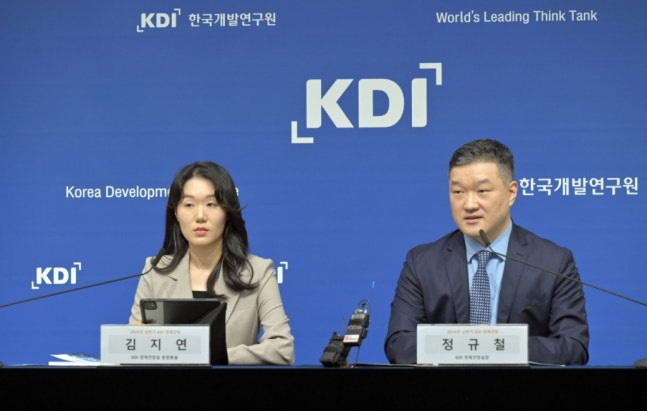
Photo provided by Korea Development Institute (KDI), ‘The Korea Development Institute (KDI), a government-funded research institute, has revised up this year’s growth forecast for South Korea by 0.4 percentage points to 2.6% from the previous estimate. KDI suggested transitioning the focus of monetary policy from tightening to neutrality.’,
,
, “In its ‘2024 Economic Outlook for the First Half’ released on the 16th, KDI projected this year’s growth rate to be 2.6%. This level exceeds the previous forecasts of 2.2% made in November last year and in February this year. This result reflects the significantly higher-than-expected 1.3% growth in the first quarter Gross Domestic Product (GDP). KDI’s growth forecast for next year is 2.1%.”,
,
, ‘Since the announcement of the first quarter GDP by the Bank of Korea on the 25th of last month, major institutions have been revising up South Korea’s growth forecast for this year. The Organization for Economic Cooperation and Development (OECD) forecasted South Korea’s growth rate for this year to be 2.6%, an upward revision of 0.4 percentage points, on the 2nd of this month. Prior to the announcement of the first quarter GDP, the government and the International Monetary Fund (IMF) had forecasted growth rates of 2.2% and 2.3% respectively for this year.’,
,
, ‘KDI stated, “Recently, despite the continued economic downturn, our economy is showing signs of relief due to a strong increase in exports.” However, they explained, “Considering that industrial production indicators calculated on a monthly basis are still showing a mild growth trend, it is judged that it may be difficult to sustain the high growth rate seen in the first quarter.”‘,
,
, ‘Especially, domestic demand, which showed positive indicators in the first quarter GDP, still remains a question mark. KDI noted, “With the continued high interest rate environment, consumption and investment are not showing clear signs of recovery.” On the other hand, exports, which are on a strong uptrend, were diagnosed as continuing the recovery trend, particularly led by semiconductors, contributing to the alleviation of economic downturn.’,
,
, ‘As per KDI’s explanation, the slow recovery of domestic demand and the rapid growth of exports are representative phenomena reflecting the recent state of the South Korean economy. Despite the slow recovery in domestic demand, fueled by the growth in exports, KDI forecasts that “South Korea is expected to gradually enter an economic recovery phase,” indicating a neutral level of economic conditions by 2025.’,
,
, ‘Jung Kyu-Cheol, Director of KDI’s Economic Outlook Division, stated, “Looking at GDP and other indicators, we believe that the most difficult period for our economy was in the first half of 2023, and that we have passed that low point.” He added, “However, as we have not yet reached a neutral level in terms of the current trend, we are moving from that low point to a neutral level, and therefore we expressed that the economic downturn is easing.”‘,
,
, ‘KDI identified several risk factors for this forecast, including △a spike in international oil prices due to escalating conflicts in the Middle East △deterioration of the financial health of Chinese construction companies leading to an economic slowdown in China △intensification of protectionist trade policies globally after the U.S. presidential election at the end of 2024, which could result in a contraction of global trade.’,
,
, ‘Regarding policy directions, KDI emphasized the need to gradually normalize macroeconomic policies within the framework of establishing a stable price trend. They stated that adjustments to the tracks of the two major macroeconomic policies, monetary policy and fiscal policy, are necessary.’,
,
, ‘In particular, they mentioned, “Considering that the inflation rate is expected to become more stable and approach the price stability target in the latter half of this year, it is possible to gradually ease the current tightening bias of monetary policy towards a neutral level.” They also indicated that with regard to fiscal policy, it is desirable to gradually reduce the fiscal deficit to a level that complies with the government’s fiscal guidelines.’,
,
, ‘KDI assessed that adjustments in expenditure structures are necessary in light of demographic changes such as aging. They proposed specific tasks such as reflecting improvements in the health of the elderly in the recalibration of the elderly age bracket, and revising the calculation method of local education subsidies to account for the decrease in school-age population due to low birth rates.’, ‘article_split’,
,

